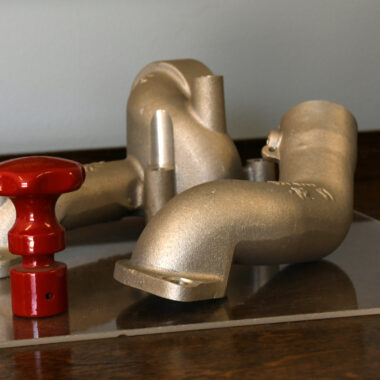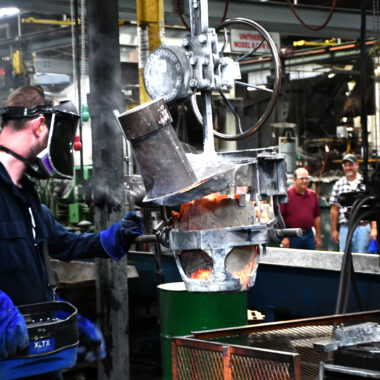Transforming Visions into Reality: Aluminum Casting Illinois
Transforming Visions into Reality: Aluminum Casting Illinois
Blog Article
Understanding the Craft: Expert Tips for Flawless Light Weight Aluminum Casting Results
In the realm of light weight aluminum proficiency, casting and precision are extremely important to accomplish flawless results. Mastering the craft requires a meticulous understanding of the devices and equipment at one's disposal, an eager eye for preparing the aluminum alloy to precise specs, and a nimble hand in using optimal casting strategies. The true mark of a seasoned professional lies in their capability to attain flawlessly smooth surface area finishes that elevate the quality of the final product. Quality assurance and troubleshooting are essential parts that can make or break a casting job, making certain that every step is carried out with miraculous treatment and attention to detail.
Essential Tools and Tools
Aluminum casting calls for details devices and tools to ensure precision and performance while doing so. Crucial tools consist of a crucible, mold, ladle, and heating system. The crucible, generally made from graphite or ceramic products, stands up to high temperature levels required to thaw aluminum. A well-insulated furnace efficient in getting to temperature levels over 1200 ° C is vital to liquefy the steel. The mold, usually constructed from steel or sand, forms the molten aluminum into the preferred kind. A ladle is used to transfer the fluid metal from the crucible to the mold without spillage.
In addition, tools like tongs, gloves, and aprons are necessary to make certain the security of operators working with molten light weight aluminum. Spending in premium tools and tools not only enhances the precision of light weight aluminum casting however likewise contributes to an extra secure and effective production process.
Preparing the Aluminum Alloy
To make sure the success of the aluminum casting procedure, meticulous preparation of the alloy is paramount. The initial step in preparing the aluminum alloy is to thoroughly select the appropriate type of light weight aluminum based on the characteristics needed for the last item.
After cleaning, the next critical step is to heat the light weight aluminum to the suitable temperature for spreading. In general, meticulous prep work of the aluminum alloy sets the structure for a successful casting procedure and high-quality end outcomes.
Optimum Casting Techniques
Applying specific casting methods is essential for attaining premium outcomes in aluminum spreading procedures. One vital strategy is ensuring correct mold preparation. This entails precise cleansing and finish of the mold and mildew to stop aluminum from sticking and make certain smooth casting. In addition, managing the pouring temperature is important. The light weight aluminum needs to be warmed to the ideal temperature level to decrease issues like shrinkage and porosity in the final cast.
Furthermore, keeping regular pouring rate and pressure is crucial to achieving harmony in the cast piece. Slow-moving and constant putting assists avoid turbulence and air entrapment, which can cause flaws. One more vital aspect is using degassing agents to remove contaminations and gases from the molten light weight aluminum, leading to a cleaner end product.

Getting Smooth Surface Area Finishes
For suppliers looking for to enhance the aesthetic allure and high quality of their aluminum spreadings, achieving smooth surface area coatings is an indispensable aspect following exact casting techniques and correct air conditioning procedures. One secret technique to accomplish smooth surface area finishes is by using top notch molds that are properly prepared and kept. The mold surface need to be carefully cleaned up and coated with release representatives to visit the website avoid imperfections moving onto the cast light weight aluminum during the cooling process.
Furthermore, managing the air conditioning price of the aluminum spreading is crucial for accomplishing a smooth surface coating. Rapid air conditioning can lead to thermal slopes that lead to emerge problems, while sluggish air conditioning might trigger microstructural problems - aluminum casting illinois. By applying controlled cooling procedures, such as utilizing air or water quenching methods, makers can make sure that the light weight aluminum solidifies uniformly, minimizing the likelihood of surface area flaws
Along with mold and mildew quality and cooling down procedures, post-casting therapies like shot blasting or chemical etching can additionally improve the surface finish of light weight aluminum spreadings. These strategies aid smooth out any kind of remaining roughness or impurities, causing a perfect look that satisfies the highest possible quality criteria.
High Quality Control and Troubleshooting

In the world of troubleshooting, it is vital to have a comprehensive understanding of typical defects that can occur throughout aluminum casting, such as surface area, shrinkage, or porosity irregularities. Constant renovation through quality control and troubleshooting practices is basic to attaining remarkable outcomes in aluminum casting.
Final Thought
In conclusion, understanding the craft of light weight aluminum casting calls for necessary tools and equipment, appropriate preparation of the light weight aluminum alloy, ideal spreading techniques, attaining smooth surface coatings, and executing visit quality assurance procedures. By following these professional tips, remarkable results can be attained in aluminum spreading procedures. Quality control and troubleshooting are necessary elements to consider to make certain high-quality and consistent lead to aluminum find this spreading jobs.
The first action in preparing the light weight aluminum alloy is to thoroughly pick the ideal type of light weight aluminum based on the attributes required for the last product.Carrying out precise spreading strategies is vital for attaining premium outcomes in light weight aluminum casting processes. By understanding these optimal casting strategies, manufacturers can constantly generate flawless light weight aluminum spreadings.
For makers seeking to boost the aesthetic allure and quality of their aluminum castings, accomplishing smooth surface finishes is an important element adhering to specific spreading techniques and proper cooling procedures.In conclusion, grasping the craft of aluminum casting requires vital tools and devices, appropriate preparation of the aluminum alloy, optimal casting techniques, achieving smooth surface area coatings, and applying top quality control actions.
Report this page